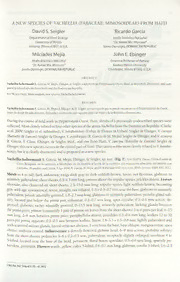
A NEW SPECIES OF VACHELLIA (FABACEAE: MIMOSOIDEAE) FROM HAITI PDF
Preview A NEW SPECIES OF VACHELLIA (FABACEAE: MIMOSOIDEAE) FROM HAITI
“ NEW A OF FROM SPECIES VACHELLIA (FABACEAE: MIMOSOIDEAE) HAITI David Seigler Ricardo Garcia S. Department ofPlant Biology Jardin Botdnico Nacional A DOMINICAN Urbana, 61801, US. Santo Domingo, REPUBLIC Illinois John Milciades Mejia Ebinger E. Jardin Botdnico Nacional Emeritus Professor of Botany Rafael Ma. Moscoso Eastern University “Dr. Illinois DOMINICAN Santo Domingo, REPUBLIC Charleston, Illinois 61 920, U.S.A. ABSTRACT RESUMEN Seigler, es una especie que se puede encontr; I. liti, de donde ha sido descrii especies afines de Haiti y de la Republica Doi i During the course of work in Departement Ouest, Haiti, shrubs of a previously undescribed species were field collected. Most closely related to four other species of the genus Vachellia from the Dominican Republic (Clarke & & Ekman et al. 2009; Seigler et submitted), barahonensis (Urban in Urban) Seigler Ebinger, V. cucuyo al. V. & & & & (Bameby M. and azuana Zanoni) Seigler Ebinger, oviedoensis (R. Garcia Mejia) Seigler Ebinger, V. V. & & & (Bameby R. Garcia, T. Clase, Ebinger, Seigler, ined., and one from Haiti, V. caurina Zanoni) Seigler Ebinger, this new species occurs in the central part of Haiti. This taxon seems most closely related to V. baraho- new nensis, but is clearly distinctive and is proposed as a species. it & km Vachellia koltermanii R. Garcia, M. Mejia, Ebinger, Seigler, sp. nov. (Fig. 1). Type: HAITI. Quest: 13 al none de m Shrub to 4 bark unknown; twigs dark gray to dark reddish-brown, terete, not flexuous, glabrous to tall; mm minutely present above the stipular spines; prickles absent, leaves puberulent; short shoots, 0.5-1.3 long, mm becoming spines reddish-brown, alternate, also clustered on short shoots, 2.5-15.0 long; stipular light mm gray with 1-5 x 0.3-0.7 near the base, glabrous to minutely age, symmetrical, straight, not inflated, terete, mm puberulent; petiole adaxially grooved, 1.0-2.3 long, glabrous to minutely puberulent; petiolar gland soli- mm mm tary, located below pinna columnar, 0.2-0.7 long, apex circular, 0.2-0.6 across, de- just the pair, mm pressed, glabrous; rachis adaxially grooved, 0-13.5 long, minutely puberulent, lacking glands between 6-15 the pinna pairs; pinnae (commonly pair of pinnae on leaves from the short shoots) 2 to 6 pairs per leaf, 1 mm mm mm long, 2-6 between pinna paraphyllidia absent; petiolules 0.2-0.6 long; leaflets 12 to 32 pairs; mm mm, pairs per pinna, opposite, 0.2-0.5 between leaflets, linear, 1.8-3.5 x 0.5-0.8 lightly puberulent and with from base margins apex scattered minute glands, veins not obvious, 1 vein the base, oblique, entire, lateral mm 6-9 obtuse; midvein densely-flowered globose head, across, probably solitary central. Inflorescence a mm, from 4 the short shoots; peduncles 3-6 x 0.2-0.5 puberulent; receptacle slightly enlarged; involucre to mm 5-lobed, bracts spatulate, 0.3-0.6 long, sparsely pu- located near the base of the head, persistent; floral mm berulent, persistent. Flowers yellow; calyx 5-lobed, 0.4-0.7 long, glabrous; corolla 5-lobed, 1.6-2.3 sessile, gland, c petiolar e, leaflets, b. mm stamen filaments stamens long, lightly puberulent, lobes one-quarter the length of the corolla; 17-26; mm mm 7-10 23-35 x 3.0-4.0 long, distinct; ovary lightly pubescent, stipe absent to 0.3 long. Fruits oblong, mm, slightly curved, nearly terete in cross section, not constricted between the seeds, coriaceous, not striate mm apex but wrinkled, glabrous, eglandular, indehiscent, dark reddish-brown to black; stipe 0.3-0.7 long; obtuse, not beaked. Seeds unknown. Some of these data were obtained from a mass of spider-webs attached to one of the specimens (ILL) i° which detritus including a few leaflets and peduncles with an involucre and floral bracts attached to the recep- and a few Vachellia flowers were imbedded. tacle, — Flowers. May-July. — Chromosome number Not determined. . — and low Distribution Dry thorn-scrub vegetation in Departement Ouest, Haiti. This species occurs at . 400 where dry intermediate elevations m), there a definite season. (to is — Etymology Named Duane Kolterman, Herbario, Universidad de Puerto Rico, Mayaguez, one of the col- after . lectors and a student of rare and endangered species of the Greater Antilles. . SeigleretalJ KEY TO SPECIES OF VACHELL1A FROM THE DOMINICAN REPUBLIC AND HAITI Legumes inflated, nearly terete in cross section, seeds in two rows (biseriate) or irregularly arranged Vachellia farnesiana c. Legumes not inflated, mostly flat in cross section, seeds in a single row. c. mm d. Legumes less than 60 long, not constricted between seeds. mm two e. Mostly pairs of pinnae per leaf; leaflets 0.6-2.0 wide, glabrous, lateral veins obvious Vachellia < mm, e. Pinnae 2 to 6 pairs; leaflets 0.5-0.8 lightly puberulent, lateral veins not obvious Vachellia kolte ACKNOWLEDGMENTS The authors wish thank Kanchi Gandhi advice concerning questions of nomenclature and Scott Zona to for and an anonymous reviewer for helpful comments. Nonetheless, the views (and errors) in this manuscript are We own our and do not necessarily reflect their judgments. wish to acknowledge support by the National We Science Foundation (NSF 04-15803) and the University of Illinois Research Board (1994, 2001). wish to DEB acknowledge support by the National Science Foundation (NSF 04-15803) and by the American We Philosophical wish thank Alexa Musgrove the preparation of drawings. Society (1992). to E. for REFERENCES Clarke, H.D., D.S. and 2009. Taxonomic revision of the Vachellia acuifera species group (Fabaceae: Seksler, Ebinger. J.E. Mimosoideae) the Caribbean. 34:84-101 in Syst. Bot. Seksler, D.S., R. Garcia, T. Clase, and J.E. Ebinger. Submitted. A new species of Vachellia (Fabaceae: Mimosoideae) from the Dominican Republic. Novon.
